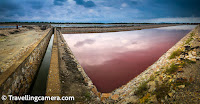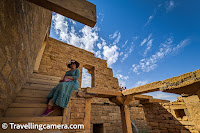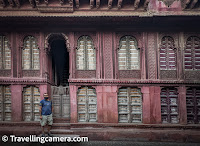Alwar Palace is popularly known as the City Palace of Alwar. The city of Alwar in Rajasthan abounds with this wonderful architectural piece built in 1793 by Maharaja Bakhtawar Singh. This Palace represents an ideal contribution to both Rajput and Mughal styles of architectural designs. The palace, located against the picturesque Aravalli Hills backdrop, testifies to the grandeur of the royal history of Rajasthan and to the finesse of its architecture. Its marvelous courtyards and intricately designed ornate balconies make Alwar Palace a place that cannot be avoided when it comes to exploring the treasure houses of Rajasthan's cultural heritage.
Alwar Palace and Its Historical Significance
This City Palace in Alwar was built in the late 18th century by Maharaja Bakhtawar Singh as a residence and an administrative center for the king. Successive rulers down the ages added more sections and other ornamentation to the palace to reflect the changing tastes of the royal family. Through the centuries, the palace complex became the stronghold of the Kachwaha Rajput dynasty that ruled Alwar.
Of paramount importance in the political history of the region is the palace that has witnessed several battles and alliances along with the rise and fall of the Alwar princely state. Today, it serves as a source of cultural doling out of its rich lifestyle and past of the Alwar royals.
Architectural Points of Interest about Alwar Palace
The architecture of Alwar Palace is an artistic mix of grandeur of Rajputana and elegance of Mughal, featured by intricate carvings, ornate motifs, and beautifully designed spaces that portray the artistic excellence of the period.
Important Architectural Features:
Central Courtyard (Rajasthani Influence): The palace has an open courtyard like most traditional Rajput architecture. The middle courtyard serves as the center point of the entire palace, facilitated by the corridors and rooms opening up onto the various sections.
Marble Pavilions (Chhatris): Inside the palace, there are several chhatris or marble pavilions having beautiful white marble carvings in them. These pavilions seem to be used by the royal family as resting places to view and enjoy the serene beauty of the garden and surroundings.
Ornate Doorways and Balconies: One of the most striking features about the Alwar Palace is doorways with balconies that are elaborately designed with floral designs, geometric motifs, and ornate arches that reflect unique Rajasthani and Mughal styles.
Palace Complex: This has a well-developed Mughal style garden which adds more beauty to the place. The symmetrical Mughal gardens and fountains along with lush green trees create a calming atmosphere that complements the theme of the palace.
The most important parts of the palace have been utilized as a Government Museum of Alwar, which, apart from having a very interesting collection of paintings, manuscripts, weaponry, and rare articles, has taken many pieces directly from the personal collection of the royals. The collections on display in the museum reflect on rich cultural and artistic heritage in Alwar and the broader Rajasthan region.
Government Museum of Alwar
Government Museum of Alwar Government Museum of Alwar is located within the City Palace and contains historical and cultural riches within its premises that represent the area's rich royal heritage. Established in 1940, this museum has an excellent collection of artifacts: Miniature Paintings: The government museum has some of the finest pieces of Rajasthani miniature paintings with items from Alwar School, including folklore, mythological stories, and court life.
Arms and Armory: The exclusive impression of swords, shields, and other weapons used by the Rajput warriors signifies chivalry and martial traditions of the place.
Articles and Antiques: The museum has several sculptures, pottery, and decorative objects that illustrate artistic skills and cultural influences of the time.
The Royal Collection and Legacy
Another attraction special in the museum is the collection of royal memorabilia of antique furnishings, textiles, and personal items that belonged to the former rulers of Alwar. The beautifully decorated ceiling in the ornate Durbar Hall within the palace is marked with grandeur of the royal court with portraits of the royalty adorning it.
Interesting Facts about Alwar Palace
One of the places which beautifully depicts the blend of Mughal, Rajput, and British colonial styles of architecture; reflects the shifting taste and influences of the successive rulers ruling over the several centuries.
City Palace Alwar has been the seat of such cultural activities like music, dance, and art, which have led to the preservation and propagation of Rajasthani culture.
Historical Importance: Alwar Palace has been the centre of great political activity since the British period. Dignitaries were given welcome and crucial meetings used to take place at Alwar Palace in this era.
Best Time to Visit Alwar Palace
Best time to visit Alwar Palace is during the winter months from October till March when the climate is cool and pleasant, ideal for interior visits at the palace complex and other ancient places in Alwar. This period is actually pleasant enough outside, so enjoy the exquisiteness of the palace on foot and pay your respects to the fine architecture.
How to Reach:
By Road: Alwar is also well connected by road to major cities in Rajasthan and other neighboring states. One can reach the City Palace easily from Jaipur, Delhi, and its surrounding regions in a car or taxi.
By Train: The Alwar Junction Railway Station is well connected to major cities like Delhi, Jaipur, and Mumbai. From the railway station, one can take a taxi or auto-rickshaw to reach the palace.
By Air: The nearest airport is the Jaipur International Airport, located approximately 150 kilometers from Alwar. From there, you can hire a cab or public transport to reach Alwar.
Places to Visit Nearby
You may also visit the following nearby places while you are here visiting the Alwar Palace:
Sariska Tiger Reserve: It is a wildlife sanctuary known for its tiger population and it lies around 35 kilometers from Alwar.
Bala Quila (Alwar Fort): An ancient fort which has a panoramic view of the Alwar city and the lush Aravalli Hills as its background.
Siliserh Lake Palace: An extremely beautiful lake palace set amidst the background of Aravalli Hills, perfect for a day excursion or a retreat.
The City Palace of Alwar is not just an ancient historical monument but also a reflection of rich cultural heritage and the royal legacy of Rajasthan. With sheer architectural beauty and the enhancing exhibitions at Government Museum, it is a total destination for history lovers and travelers. Whether you are exploring the little details of this design or reading through the history of the royal family, visiting Alwar Palace will be a rich experience that keeps you connected to the grandeur of Rajasthan's past.
Related Blogposts:
 Amber Fort in Rajasthan : The Pearl of Jaipur's Rajput Architecture
Amber Fort in Rajasthan : The Pearl of Jaipur's Rajput Architecture
 Chand Baori in Abhaneri: A Marvel of Ancient Indian Architecture in Rajasthan
Chand Baori in Abhaneri: A Marvel of Ancient Indian Architecture in Rajasthan
 Bhandarej Baori: An Ancient Stepwell of Rajasthan's Heritage
Bhandarej Baori: An Ancient Stepwell of Rajasthan's Heritage
.jpg) Tour de Churu Streets having grand havelis with marvelous fresco paintings | Haveli Heritage Tour Rajasthan, India
Tour de Churu Streets having grand havelis with marvelous fresco paintings | Haveli Heritage Tour Rajasthan, India
 Beautiful Vyas Chhatris in Jaisalmer, Rajasthan || the most unusual sunset point built in a cremation ground
Beautiful Vyas Chhatris in Jaisalmer, Rajasthan || the most unusual sunset point built in a cremation ground
 Magnificent Cenotaphs at the Bada Bagh, Jaisalmer, Rajasthan || Exorbitant Ticket Prices can be a deterrent to anyone visiting the place
Magnificent Cenotaphs at the Bada Bagh, Jaisalmer, Rajasthan || Exorbitant Ticket Prices can be a deterrent to anyone visiting the place
 An interesting drive from Kuldhara to Khaba Fort, Dedha, Jaisalmer, Rajasthan || The Journey was definitely worth the visit to this beautiful little fort
An interesting drive from Kuldhara to Khaba Fort, Dedha, Jaisalmer, Rajasthan || The Journey was definitely worth the visit to this beautiful little fort
 A half day detour to Sambhar Salt Lake, Rajasthan from NH48 || What makes India's Largest Inland Salt Lake worth visiting in winters?
A half day detour to Sambhar Salt Lake, Rajasthan from NH48 || What makes India's Largest Inland Salt Lake worth visiting in winters?
 A fulfilling stop at Mandore in Jodhpur, Rajasthan || The old seat of the Rathore clan and also the birthplace of Mandodari
A fulfilling stop at Mandore in Jodhpur, Rajasthan || The old seat of the Rathore clan and also the birthplace of Mandodari
 The Golden Fort of Jaisalmer, Rajasthan || A thriving, pulsating mini city within the walls of the fort
The Golden Fort of Jaisalmer, Rajasthan || A thriving, pulsating mini city within the walls of the fort
 The splendid architecture of Patwon ki Haveli in Jaisalmer, Rajasthan || One of the most opulent of the havelis in Jaisalmer
The splendid architecture of Patwon ki Haveli in Jaisalmer, Rajasthan || One of the most opulent of the havelis in Jaisalmer
 The Abandoned Village of Kuldhara near Jaisalmer, Rajasthan || Facts and Fables about why the Paliwal Brahmins abandoned this village of their ancestors
The Abandoned Village of Kuldhara near Jaisalmer, Rajasthan || Facts and Fables about why the Paliwal Brahmins abandoned this village of their ancestors
 The Amazing Pokaran Fort near Jaisalmer, Rajasthan || A beautiful structure that effortlessly blends with the desert landscape it is built in
The Amazing Pokaran Fort near Jaisalmer, Rajasthan || A beautiful structure that effortlessly blends with the desert landscape it is built in
 Vedi Temple inside KumbalGarh Fort, Rajasthan - 3 Storey Octagonal structure standing strong on 36 pillars around world's second largest wall
Vedi Temple inside KumbalGarh Fort, Rajasthan - 3 Storey Octagonal structure standing strong on 36 pillars around world's second largest wall

-%20A%20Peep%20into%20the%20Royalty%20Heritage%20of%20Rajasthan-1-2.jpg)
-%20A%20Peep%20into%20the%20Royalty%20Heritage%20of%20Rajasthan-1.jpg)
-%20A%20Peep%20into%20the%20Royalty%20Heritage%20of%20Rajasthan-2.jpg)
-%20A%20Peep%20into%20the%20Royalty%20Heritage%20of%20Rajasthan-3.jpg)
-%20A%20Peep%20into%20the%20Royalty%20Heritage%20of%20Rajasthan-2-2.jpg)

.jpg)
















.jpg)

.jpg)
Comments